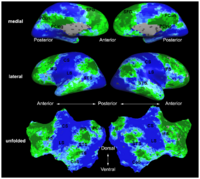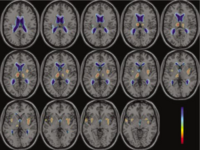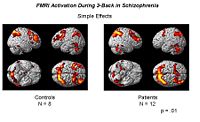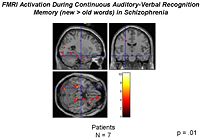NA-MIC Internal Collaborations:fMRIAnalysis
Back to NA-MIC Internal Collaborations
fMRI Analysis
Functional Activation Analysis

|
fMRI clusteringIn this project we study the application of model-based clustering algorithms in identification of functional connectivity in the brain. More... New: P. Golland, Y. Golland, R. Malach. Detection of Spatial Activation Patterns As Unsupervised Segmentation of fMRI Data. In Proceedings of MICCAI: International Conference on Medical Image Computing and Computer Assisted Intervention, 110-118, 2007. |

|
Neural Substrates of ApathyWe recently observed reduced volume of the frontal lobe in patients with schizophrenia having high levels of apathy (link to journal below). In the present investigation we are extending our study of the structural correlates of apathy in schizophrenia using the NAMIC toolkit with an emphasis on basal ganglia. More... New: Feb 22, 2006: Sylvain Bouix to visit Dartmouth. |

|
Neural Substrates of Working Memory in SchizophreniaThis project assesses working memory using an auditory verbal version of the n-back task paradigm. Three conditions are presented in blocks in counterbalanced order with increasing working memory load demands (0-, 1-, 2- and 3-back). More... New: December 20, 2005: Marek Kubicki visit to Dartmouth. |

|
fMRI Detection and AnalysisWe are exploring algorithms for improved fMRI detection and interpretation by incorporting spatial priors and anatomical information to guide the detection. More... New: Wanmei Ou, Sandy Wells, Polina Golland. Bridging Spatial Regularization And Anatomical Priors in fMRI Detection. In preparation for submission to IEEE TMI. |

|
Brain Activation during Continuous Verbal Encoding and Recognition Task in SchizophreniaThis project employs an event-related auditory verbal episodic memory probe targeting medial temporal and DLPFC circuitry. The task uses a continuous performance format where concrete nouns are presented initially as new items. Words are then repeated after short or long intervals and the participant is required to make a new/old distinction. This design permits analysis of both encoding and recognition processes. More... New: December 20, 2005: Marek Kubicki visit to Dartmouth. |